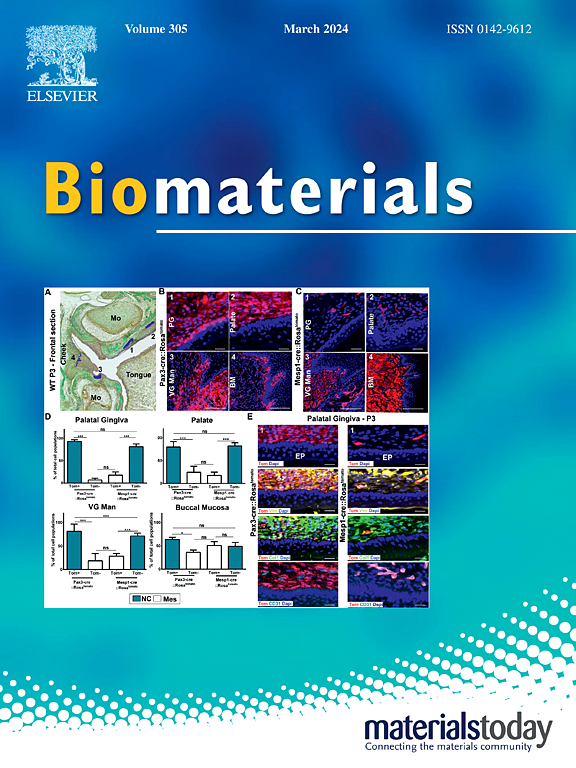双功能级联单原子纳米酶通过双重抑制PD-L1和调节缺氧来增强光动力免疫治疗。
IF 12.9
1区 医学
Q1 ENGINEERING, BIOMEDICAL
引用次数: 0
摘要
光动力免疫疗法作为一种很有前景的抗肿瘤治疗方式,已被广泛应用于多种实体肿瘤的治疗。然而,肿瘤缺氧状态和免疫抑制微环境严重限制了PDIT的治疗效果。在这里,我们设计了一个发夹四面体DNA纳米结构(H-TDN)修饰的双功能级联铂单原子纳米酶(PCFP@H-TDN),并包封了光敏剂。PCFP@H-TDN具有双酶样活性,可催化级联反应产生充足的O2,逆转肿瘤缺氧,从而显著增强PDIT的抗肿瘤作用。同时,H-TDN不仅可以阻断程序性死亡1 (PD-1)/程序性死亡配体1 (PD-L1)识别通路,还可以靶向PD-L1反义寡核苷酸的递送,降低肿瘤细胞表面PD-L1蛋白的整体表达,实现阻断PD-1/PD-L1通路和抑制PD-L1蛋白表达的结合。双抑制PD-L1显著提高免疫检查点阻断效果。体内研究表明,构建的PCFP@H-TDN通过增强肿瘤免疫原性和上调肿瘤部位免疫细胞浸润,以多模式协同提高肿瘤的治疗效果。本研究提供了一种有效的纳米药物通过抑制PD-L1和调节缺氧来提高PDIT。本文章由计算机程序翻译,如有差异,请以英文原文为准。
Bifunctional cascaded single-atom nanozymes for enhanced photodynamic immunotherapy through dual-depressing PD-L1 and regulating hypoxia
As a promising anti-tumor modality, photodynamic immunotherapy (PDIT) has been applied for the treatment of many solid tumors. However, tumor hypoxic condition and immunosuppressive microenvironment severely limit the treatment outcome of PDIT. Here, we have designed a hairpin tetrahedral DNA nanostructure (H-TDN)-modified bifunctional cascaded Pt single-atom nanozyme (PCFP@H-TDN) with encapsulation of the photosensitizer. The PCFP@H-TDN have dual enzyme-like activities, which can catalyze cascade reactions to generate sufficient O2, reversing the tumor hypoxia and thereby significantly enhancing the anti-tumor effect of PDIT. Meanwhile, H-TDN can not only block the programmed death 1 (PD-1)/programmed death ligand 1 (PD-L1) recognition pathway but also target the delivery of PD-L1 antisense oligonucleotides to reduce overall PD-L1 protein expression on the surface of tumor cells, achieving the combination of PD-1/PD-L1 pathway blockade and PD-L1 protein expression silencing. The dual-depressing PD-L1 significantly improves immune checkpoint blockade efficacy. In vivo studies have shown that the constructed PCFP@H-TDN synergistically improved the therapeutic effect of tumors in a multimodal manner through enhancing tumor immunogenicity and upregulating immune cell infiltration at the tumor site. This study provides an efficient nanomedicine to enhance PDIT by depressing PD-L1 and regulating hypoxia.
求助全文
通过发布文献求助,成功后即可免费获取论文全文。
去求助
来源期刊

Biomaterials
工程技术-材料科学:生物材料
CiteScore
26.00
自引率
2.90%
发文量
565
审稿时长
46 days
期刊介绍:
Biomaterials is an international journal covering the science and clinical application of biomaterials. A biomaterial is now defined as a substance that has been engineered to take a form which, alone or as part of a complex system, is used to direct, by control of interactions with components of living systems, the course of any therapeutic or diagnostic procedure. It is the aim of the journal to provide a peer-reviewed forum for the publication of original papers and authoritative review and opinion papers dealing with the most important issues facing the use of biomaterials in clinical practice. The scope of the journal covers the wide range of physical, biological and chemical sciences that underpin the design of biomaterials and the clinical disciplines in which they are used. These sciences include polymer synthesis and characterization, drug and gene vector design, the biology of the host response, immunology and toxicology and self assembly at the nanoscale. Clinical applications include the therapies of medical technology and regenerative medicine in all clinical disciplines, and diagnostic systems that reply on innovative contrast and sensing agents. The journal is relevant to areas such as cancer diagnosis and therapy, implantable devices, drug delivery systems, gene vectors, bionanotechnology and tissue engineering.
 求助内容:
求助内容: 应助结果提醒方式:
应助结果提醒方式:


